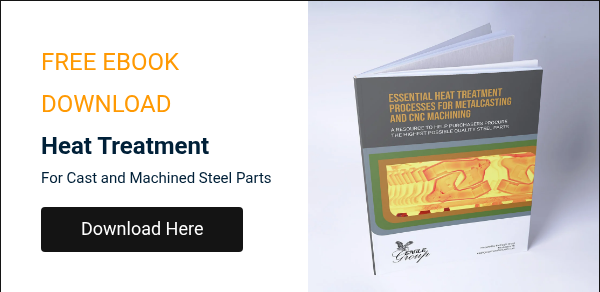Heat Treatment: Annealing

The heat treatment known as annealing encompasses a group of processing heat treatments. Unlike thermal processes that are used to improve the strength and wear resistance of a part (such as hardening heat treatments), processing heat treatments are used to prepare a workpiece for further manufacturing processes. Chiefly, this means improving a material’s responsiveness to machining or cold-working by restoring (and even enhancing) ductility.
After an annealing process, the part can be expected to go to the machine shop for additional subtractive manufacturing, or to a mill to be cold worked. In fact, annealing makes machining and cold working easier (even possible) by relieving internal stresses, reducing hardness, increasing ductility and toughness, and softening the material to make it more machinable and workable.
What Is Annealing?
Technically speaking, annealing is an umbrella term for a group of processing heat treatments. In the words of DeGarmo’s Materials and Processing:
“A number of process heat-treating operations have been classified under the general term of annealing... Because of the variety of anneals, it is important to designate the specific treatment, which is usually indicated by a preceding adjective. The specific temperatures, cooling rate, and details of the process will depend on the material being treated and the objectives of the treatment.” (1)
As such, both stress relief and normalizing are often qualified as types of annealing heat treatments, although their processes as well as their outcomes differ significantly enough that it’s common practice to describe and catalog them separately. In fact, we’ve written about stress relief and normalizing separately in our Heat Treatment Blog Series. When we refer to annealing in shorthand, we are usually talking about full (or complete) annealing. Another very common form of annealing we discuss in this article is known as process annealing. We will discuss how manufacturers like foundries and machine shops use annealing to prepare parts for delivery or for the next step in their manufacturing journey.
What Is the Effect of Annealing on Carbon Steels?
Alloys undergo a range of changes during annealing heat treatments, and what unites all annealing processes is the shared effect they have on a material’s properties. Annealing processes have the power to change a material in a multitude of ways, including:
- Reducing strength or hardness
- Removing residual stresses
- Restoring ductility
- Changing grain size
- Improving toughness
Why Annealing Is a Key Thermal Treatment for Certain Steels
What Kinds of Alloys and Parts Benefit from Full Annealing?
Compared with other heat treatment processes, full annealing is an expensive procedure. The cooling stage in annealing is a lengthy process which requires much more oven time to bring it to completion. It is this extensive ‘controlled cooling’ that results in much higher processing costs.
For this reason, full annealing is performed on parts that require superior ductility properties that cannot be achieved through the shorter heat treatment of normalizing. Many high carbon, high alloy, and tool steels are good candidates for full annealing due to their superior hardness. Other good candidates are parts with very high levels of internal stresses and grain size variation, because annealing is very effective at correcting these imbalances.
If you work in the world of high-carbon steels, such as tool steels, you’ll encounter annealing very commonly. High carbon steels are extremely hard and only annealing can soften them up enough to make them workable. The reality, however, is that many structural parts are low carbon and don’t need to be subjected to a full annealing to reach the appropriate level of softness for further processing. In these cases, normalizing is a perfectly adequate heat treatment.
Full Annealing and Machining
Machinable steels have to be sufficiently soft to allow the CNC machines to do their work of cutting a workpiece. And while there are many grades of carbon and stainless steel that are sufficiently soft after normalizing, certain high-hardness steels, such as tool steels, require extra processing to be rendered machinable. In other words, they need to be fully annealed.
Once the fully annealed steel is cut into its near-final shape, it undergoes re-hardening to bring out the desired end mechanical properties.
Process Annealing and Cold Steel Working
Process annealing is a much faster version of annealing than full annealing. As the name suggests, it is used during the production process as opposed to following a major manufacturing step (like casting).
Steels that have undergone mechanical stresses due to cold working processes have grain irregularities along the sections where they have been rolled, pressed, stamped, bent or in any other way stressed. When used on low-carbon, cold-worked steel, process annealing permits continued cold working without danger of fracture by restoring ductility to the workpiece. As a result, certain steelmakers regularly shuttle their products between the cold working equipment and furnaces, in order to continuously restore the ductility required by the cold working process.
What Is the Thermal Recipe for Annealing?
The sheer number of steel grades means that there is a wide range of possible steel chemistries, and that a particular chemistry influences the temperature required to heat an alloy above the appropriate temperature, and then how the controlled cooling cycle must be programmed to ensure success.
Firstly, an important concept in the science of annealing is understanding eutectic steel.
A steel is eutectic if it contains 0.8% carbon. Steels below this amount of carbon are known as hypoeutectic, and steels with more than 0.8% carbon are known as hypereutectic. Depending on where a steel grade falls in this equilibrium, it will behave differently upon heating, but even more importantly it will behave differently upon cooling. As such, a steel’s carbon content will influence temperatures, soaking and cooling times.
The main takeaway is that a steel’s carbon content influences the critical temperatures to which each steel piece must be heated to achieve the required annealing effects. And like with all heat treatments, the amount of alloying elements in the alloy grade have a large bearing on the exact temperature required to achieve the desired properties. For example: chromium (Cr) raises the critical temperature and manganese (Mn) lowers it.
Thermal Recipe: Full Anneal
 A full anneal can take well over a full day of processing to complete, depending on the size and dimensions of the piece. After heating the steel above the upper critical temperature, which converts the entire workpiece to austenite, the oven’s temperature is lowered incrementally in a very controlled manner (say, 15 degrees per hour) until it reaches its lower critical temperature – this phase is known as ‘ramp down.’ Once the lower critical temperature is reached, the piece can be removed from the oven and cooled in air. The lower critical temperature is a key measurement, because no temperature controls can influence how a steel’s microstructure solidifies below this temperature. The important changes happen between the upper and lower critical temperatures.
A full anneal can take well over a full day of processing to complete, depending on the size and dimensions of the piece. After heating the steel above the upper critical temperature, which converts the entire workpiece to austenite, the oven’s temperature is lowered incrementally in a very controlled manner (say, 15 degrees per hour) until it reaches its lower critical temperature – this phase is known as ‘ramp down.’ Once the lower critical temperature is reached, the piece can be removed from the oven and cooled in air. The lower critical temperature is a key measurement, because no temperature controls can influence how a steel’s microstructure solidifies below this temperature. The important changes happen between the upper and lower critical temperatures.
Once fully annealed, the microstructure is a mostly coarse pearlite that is soft and machinable (see image at right for microscopic view of pearlite microstructure). If the steel is hypoeutectic, it will also cool with some ferrite in the microstructure. If hypereutectic, the coarse pearlite will be joined by some ferrite as well as cementite.
Thermal Recipe: Process Anneal
Also known as an isothermal anneal, a process anneal takes a fraction of the time of a full anneal. It is an appropriate thermal process for less complex and dimensionally smaller parts.
Just like with full annealing, the steel is heated above its upper critical temperature and then is cooled down to a point just above its lower critical temperature. The key feature that distinguishes a partial from a full anneal is that a partial anneal is ramped down simply by setting the oven to cool to a temperature just above the lower threshold, but the cooling is not controlled (i.e., there are no incremental temperature drops, and the oven cools at its normal pace until it reaches the set temperature).
In total, a process anneal only takes a few hours and its use is mainly restricted to lower carbon steels.
How Does Annealing Compare to Normalizing?
Annealing and normalizing are both important processes for controlling a part’s end properties. The processes are similar in that they both require heating a steel past its austenization temperature before cooling it. The difference between normalizing and annealing lies in the cooling rate. Annealed steels are cooled at a controlled rate inside the oven whereas normalized steel is cooled in air, because it’s the cooling rate that dictates subsequent grain size and structure.
Each process affects the outcome of a part’s end properties differently. Relative to normalizing, annealed parts have:
- Lower strength and hardness values
- Higher ductility values
- Larger grain sizes
- Less internal stress
The main difference between annealed and normalized steel is the spacing in the grain structure of the pearlite. Both steels are predominantly made of pearlite, the name for interlapping layers of ferrite and cementite (see our Introduction to Heat Treatment for a primer on iron phases). But annealing produces a coarse or spheroidized pearlite whereas normalizing results in fine pearlite. ‘Coarse’ and ‘fine’ here describe the thickness of the layers of ferrite and cementite. Basically, the finer the layers, the easier they resist dislocations. Dislocation resistance is synonymous with strength and hardness, so normalized steel’s finer pearlite layers make for a stronger, harder steel (relative to annealed steel).
As we noted above, a good portion of low-carbon steel parts reach adequate mechanical property values through normalizing. Again here, we quote DeGarmo:
“Normalizing and annealing can be applied to all carbon contents, but even here, preferences are noted. Because different cooling rates do not provide a wide variation of properties in low carbon steels, the air cool of a normalizing treatment often produces acceptable uniformity.” (2)
Annealing at the Eagle Group
We have developed a 40-page ebook on heat treatment for cast and machined steel parts as a resource to help purchasers procure the highest possible quality steel parts. Click below and fill out a brief form to claim your free copy.
The Eagle Group has experience in a wide range of heat treatments and can help you find the appropriate thermal process for your castings. If what you need are castings with superior ductility and high levels of machinability, either full or process annealing might be the best solution for your parts. Due to the number of available choices and forms of annealing available, we recommend speaking with our product development team to help determine if annealing or a different processing heat treatment, like normalizing, is best suited to your product’s application.
Learn More About Heat Treatment in Our Dedicated Series
(1) Black, JT., & Kohser, Ronald A. (2019). DeGarmo’s Materials and Processes in Manufacturing (13th Edition). John Wiley & Sons, Inc (pg. 68)
(2) Black, JT., & Kohser, Ronald A. (2019). DeGarmo’s Materials and Processes in Manufacturing (13th Edition). John Wiley & Sons, Inc (pg. 69)
Tags: Processes, Metallurgy, Heat Treatment

Written by Jason Bergman
Jason Bergman is Senior Quality Engineer and Metallurgist at Eagle Alloy. He has been with the company since 2013.




